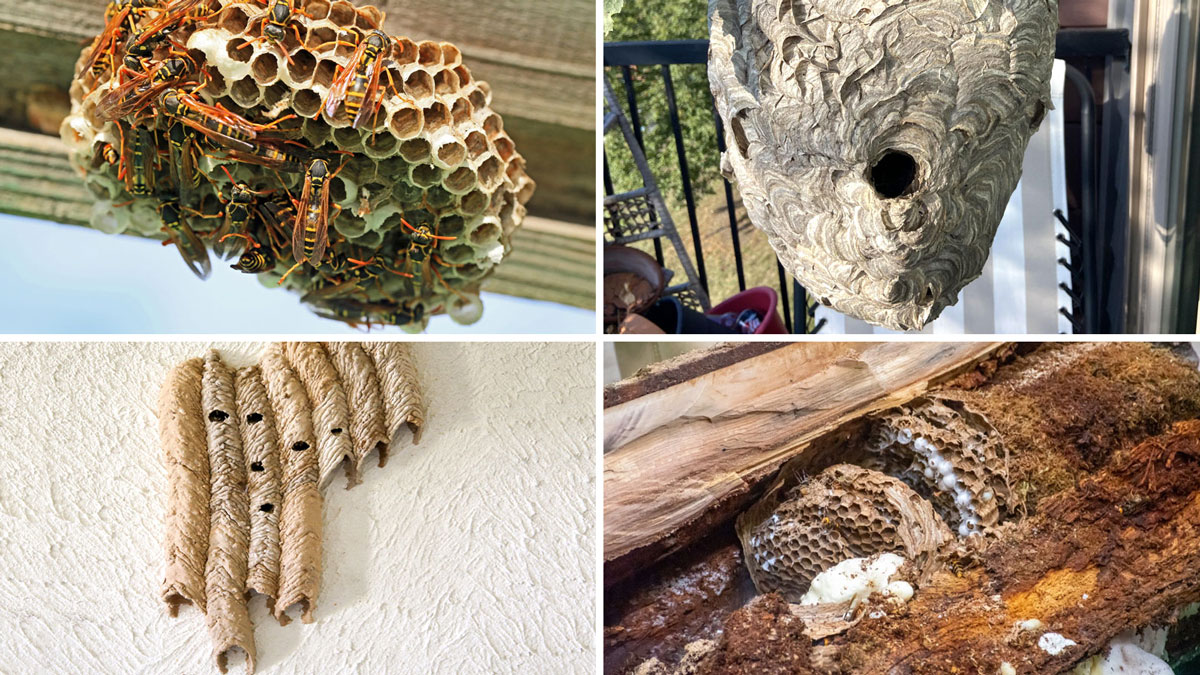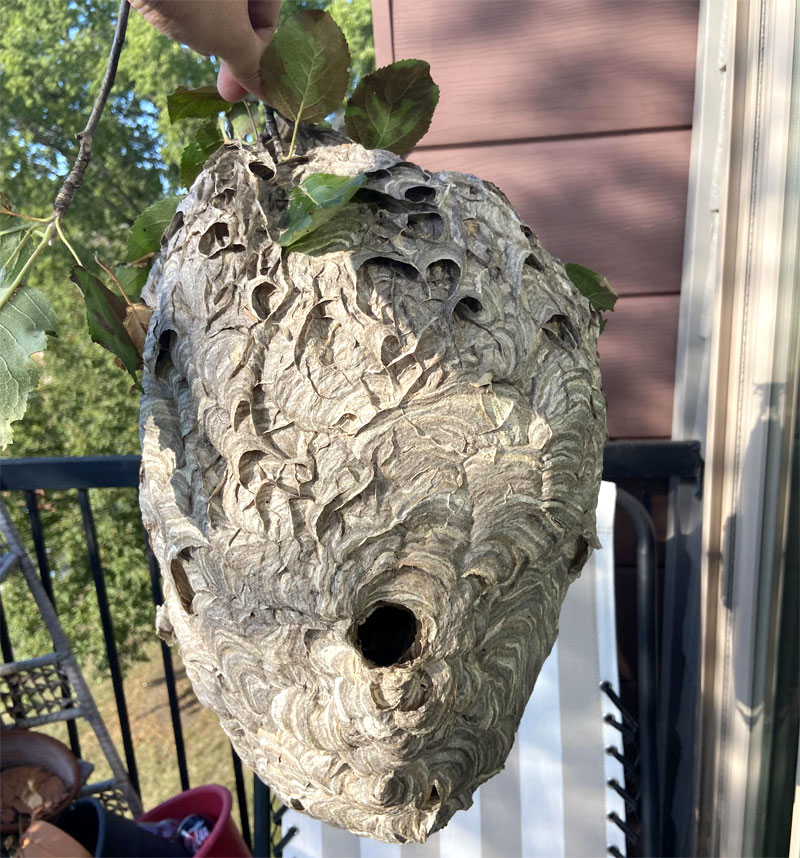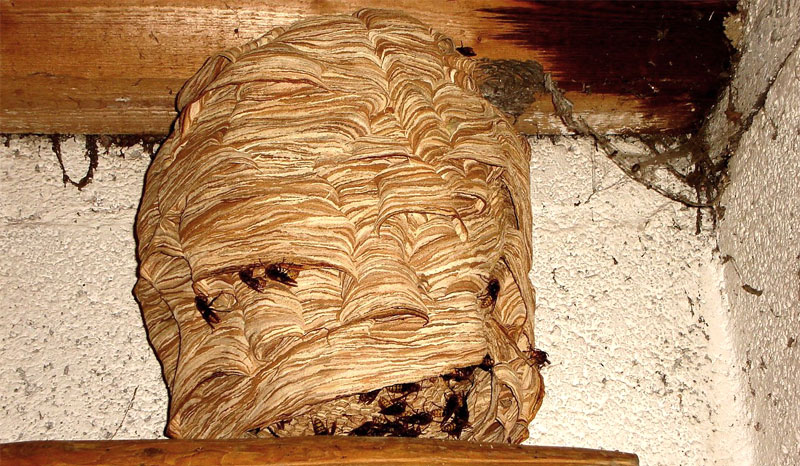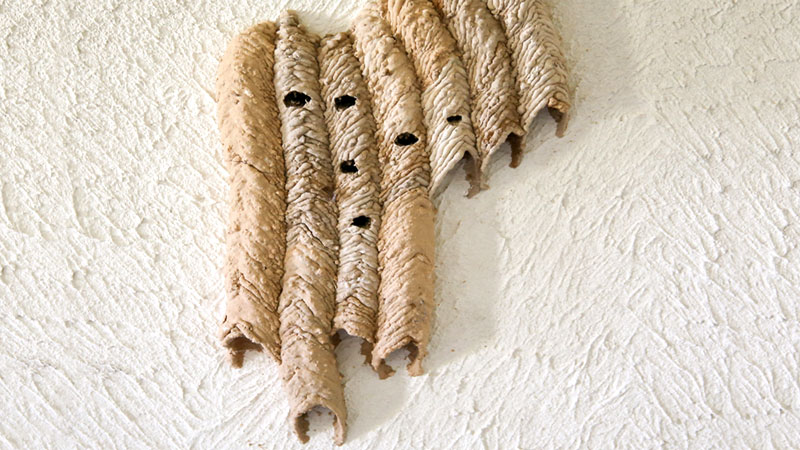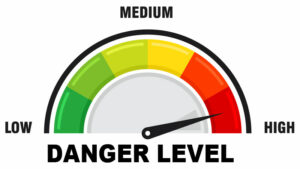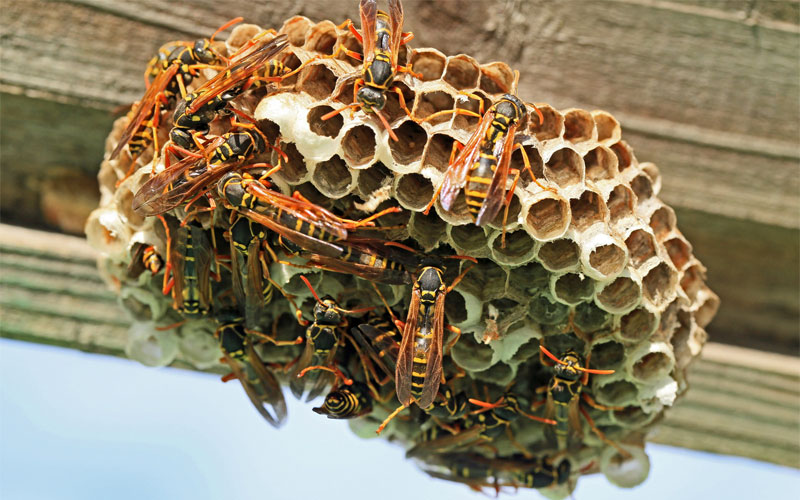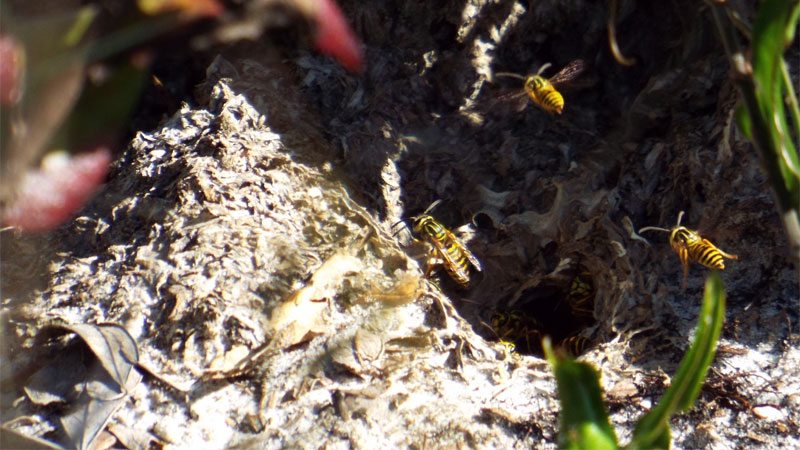Bees, wasps, and hornets – three stinging insect types that can pose a lot of problems when they set up home on your property. But while bees can certainly sting, it’s the wasps and hornets most people fear.
However, when you find a nest on your property, it’s not always easy to tell just what created it or how dangerous the nest is.
Today, we’re going to take a look at six common hornet and wasp types and show you how to identify (with a fair amount of accuracy) their nests. Once you know what you’re dealing with (and what to do once you’ve identified it) can greatly reduce the risk of stings to you and your loved ones.
Wasps vs Hornets: A Quick Primer
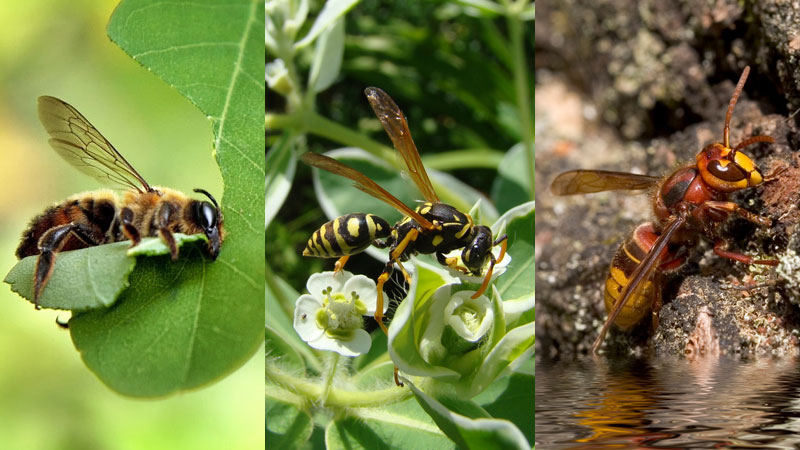
One of the great mistakes people make is to try and debate between bees, wasps, and hornets. Why is this? Because hornets are actually a type of wasp. Even worse, wasps often resemble bees, but without the fuzzy exoskeleton.
Wasps make up most of the superfamily Apoidea, most notably the family Vespidae, and there are over 14,000 different species across several genera. Of these, all members of the genus Vespa are better known as hornets.
While not always the case, hornets have a reputation for being more aggressive than most wasps – although yellowjackets have made a great effort to keep their own reputation for nastiness. As a side note, all bees come from the family Anthophila, which also belongs to this superfamily.
Bald-Faced Hornet Nest
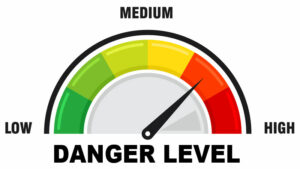
They’re extremely aggressive if they feel their nest is being threatened, making it a good thing that those structures tend to be highly visible. It’s also worth noting that this species has evolved the ability to spray its venom into the eyes of potential attackers.
Location and Size
These pests can be found across the US, but are most common in the southeastern states. In most cases, the nests are found in trees and bushes, but can also be found under rock outcroppings or on the sides of homes. A typical nest has 400 to 700 workers.
Outside Appearance
Perhaps part of the reason these yellowjackets are referred to as hornets is the appearance of their nest. The exterior is egg-shaped and roughly 23 inches long and 14 inches across. The exterior is a gray, mottled mass of pulp similar to that of paper wasps.
Inside Appearance
The interior of the nest is a series of combs containing multiple hexagonal chambers. The combs themselves are also roughly hexagonal and can vary in size from one nest to another.
How to Deal With It
This is one nest to avoid as much as possible, since the bald-faced hornet is notoriously aggressive towards attackers. The nest is only used for a single year, and only fertilized queens survive the winter to create new nests.
While it’s entirely possible the structure might have been abandoned, it’s worth the cost to call in a professional exterminator to deal with it just in case there are still residents.
European Hornet Nest
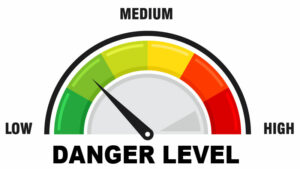
Location and Size
Found throughout much of the eastern US and as far west as eastern Oklahoma, these hornets prefer building their homes in elevated, sheltered places. This usually means in high-up tree cavities or (less often) wall voids in buildings.
You’ll most often find them in forests or more arboreal areas of suburban neighborhoods.
The overall size can be pretty big, as these are fairly large hornets. However, a colony usually only has between 200 and 400 workers, with the largest nests peaking at around 1,000 workers.
Outside Appearance
There’s not a whole lot to see on the outside, although it wouldn’t be a stretch to say the paper covering the nest can look like a mud flow or some strange canyon wall due to the many strata of dark or light wood fibers used to create it.
Inside Appearance
The interior typically has between 1,500 to 3,000 cells. They aren’t overly fancy, as the nests are only used for one year and then abandoned.
How to Deal With It
Ideally, you can wait until winter and simply remove the nest yourself. This is because the workers all die and only fertilized queens survive in hibernation. However, because of how high up these nests can be (or if you can’t wait until winter), sometimes calling an exterminator is easier.
Mud Dauber Wasp Nest
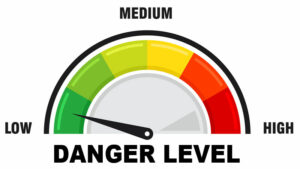
However, there are several common elements to these structures and only two tend to come up often, so those are the two we’ll be focusing on.
It should be noted that all mud dauber nests are made of daub, a form of mud mortar. Some species can build mounds along the base of a wall, while others may build tall columns similar to some ant mounds, but these examples are rare (if present at all) in the US.
Location and Size
Both organ pipe mud daubers (from the family Crabronidae) and black and yellow mud daubers (from the family Sphecidae) are common in the US and have rather easily identifiable homes. The former prefers cave walls, bridges, and similar surfaces, while the latter prefers corners and crevasses.
Despite the appearance of their nests, these are solitary wasps. However, their nests are often taken over by other species (including other mud daubers).
Outside Appearance
Organ pipe mud daubers create nests containing a series of long, hollow tubes that may be either vertical or horizontal. Conversely, black and yellow mud daubers encase their tubes in a rounded shell.
Inside Appearance
There’s actually not much to see on the inside. The tubes are used to store captured prey, each with a single egg laid on them. The egg hatches, eating the paralyzed prey alive.
How to Deal With It
These nests are generally easy to remove, although you’ll want to wear gloves just in case the wasp is at home. Simply scrape it off the wall, and if the wasp was out hunting, it will just go somewhere else when it sees the nest gone.
Murder Hornet Nest
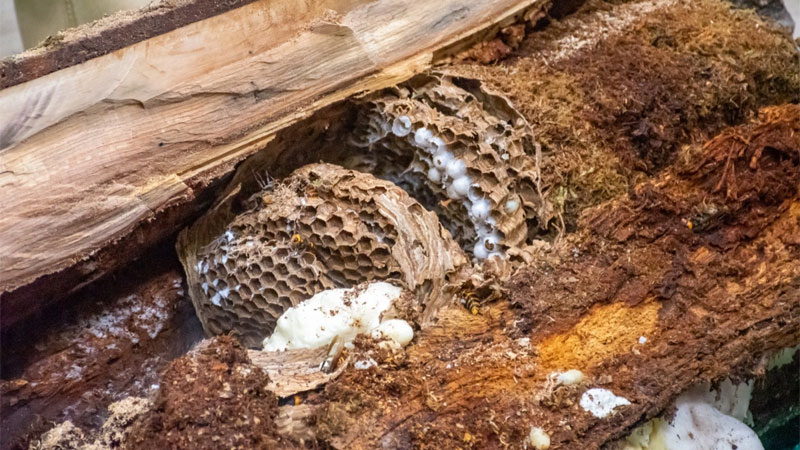
In October 2020, a murder hornet nest was found and destroyed in Washington State. Believed to be the first one on US soil, the Washington State Department of Agriculture took advantage of the find to actually crack this nest open and take a look inside.
This section describes what they found, as the Asian giant hornet (Vespa mandarinia) is one species you’re thankfully not likely to run into.
Location and Size
The nest was found inside a tree, eight feet up. It contained a frightening population, which was reported to have contained:
- six eggs
- 190 total larvae
- 108 pupae
- 112 workers
- nine drones
- 76 queens
Yes, you heard that right, 76 queens in one nest! It’s quite possible there were additional murder hornets that were away from the nest or had been killed prior to its destruction.
Outside Appearance
The nest was completely inside a tree, making it difficult to spot without first spotting the hornets.
Inside Appearance
There was some damage caused by splitting open the tree trunk. However, it was obvious that the hornets had carved out the tree’s interior to accommodate the nest. It contained six combs, with an estimated 776 cells
How to Deal With It
Walk away. Seriously, walk away very carefully so you don’t alarm the hornets and immediately call your local Department of Agriculture branch to let them know where you believe the nest to be.
Murder hornets (the Entomological Society of American decided in July 2022 that they’d rather refer to them as “northern giant hornets”, but we think referring to Asian giant hornets as “murder hornets” encourages people not to be reckless around them) are no joke, and even the Orkin Man isn’t equipped to fight them.
In fact, murder hornets can survive freezing and even a lack of oxygen, making us wonder if they’re attempting to become the first true space-faring insect from our planet.
Paper Wasp Nest

Location and Size
Paper wasps can be found just about everywhere, and they build their nests just about anywhere there’s an elevated, protected space. This can include everything from tree branches to porch roofs or even clotheslines. Depending on the species, a single nest can house up to 5,000 wasps.
Outside Appearance
These paper wasp nests look incomplete compared to a lot of other nests. The main portion has an umbrella shape made of hexagonal cells that open out on the bottom of the nest but are sealed into a smooth dome at the top. A petiole helps attach the nest to whatever surface it’s connected to.
Inside Appearance
If you see the outside of this nest, you can already see the inside, as it looks as though someone neatly sliced most of the nest off, leaving only the top.
How to Deal With It
Paper wasps tend to only become aggressive if their nest is endangered. However (like most wasps in this list), they die out every winter with only the fertilized queens surviving. This is a perfect time to remove the nest.
However, you will want to use caution when attempting to remove a nest during the warmer months (wasps can sting multiple times), and it’s usually safest to call in a professional.
Yellow Jacket Nest

Since we already spoke of that species earlier, we’ll focus on the subterranean species.
Location and Size
Found throughout the US, nests are usually the size of a basketball with a population of up to 3,000 wasps. However, in Hawai’i and the far southeast area, it’s warm enough for the nest to overwinter. In these cases, the colony can become much larger, with up to 10,000 wasps and multiple queens.
Outside Appearance
About all you’ll see (if you’re lucky) is a hole in the ground surrounded by a small mound of excavated dirt and pebbles. However, the entrance is often obscured by grass or other cover.
Inside Appearance
The nest itself resembles that of hornets, with a round, paper-covered exterior. Inside, there are many layers of cells, with the larger queen cells being located in the lowest levels near the single, bottom entrance.
How to Deal With It
When you spot a yellowjacket, there’s a good chance the nest is nearby. Trying to deal with a yellowjacket nest by yourself can be dangerous, as you could be inviting hundreds or thousands of angry wasps to have a go at your face.
The best thing to do is to call an exterminator and let them locate and destroy the nest. If it’s winter and you’re in a more temperate area, you can destroy the nest with various methods, such as boiling water. Just remember to use extreme caution.
- How to Get Rid of Hawks - March 8, 2024
- How to Get Rid of Pill Bugs (Rolly Pollies) - March 1, 2024
- How to Get Rid of Groundhogs (Woodchucks) - February 5, 2024

